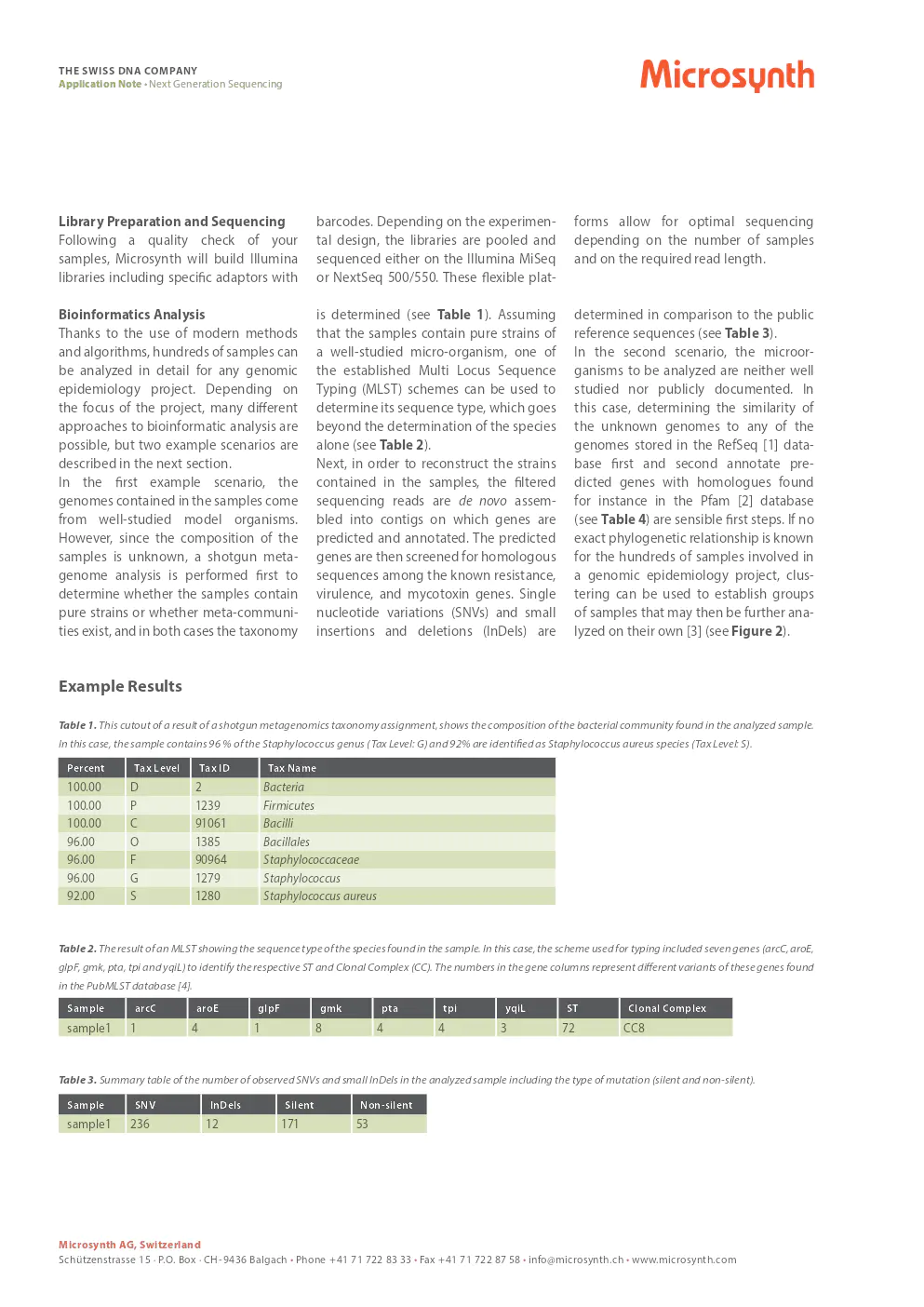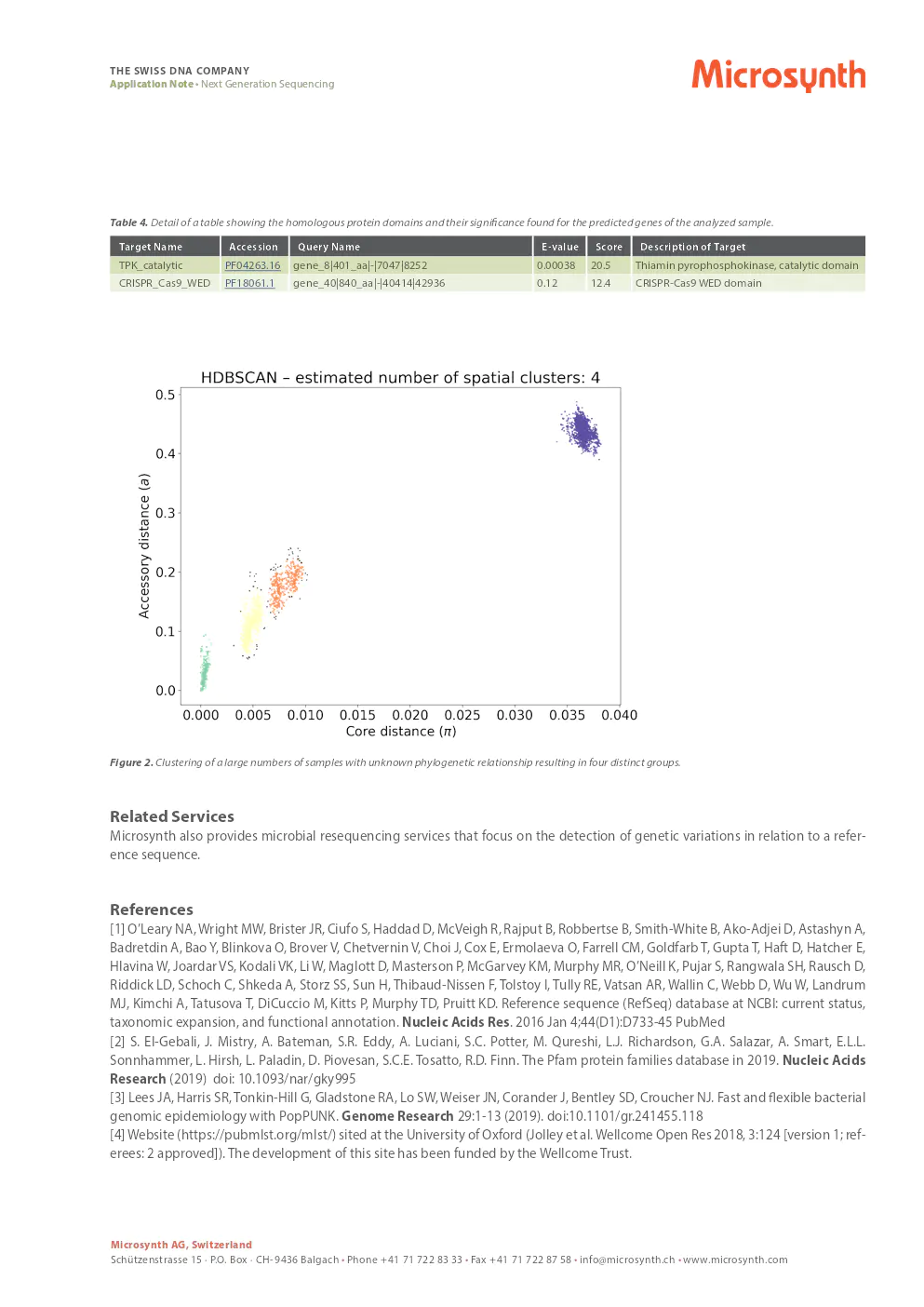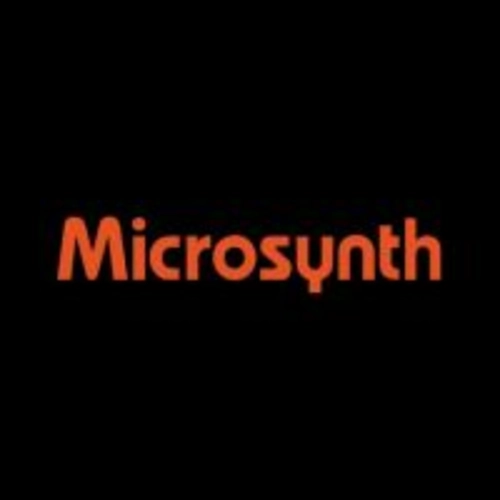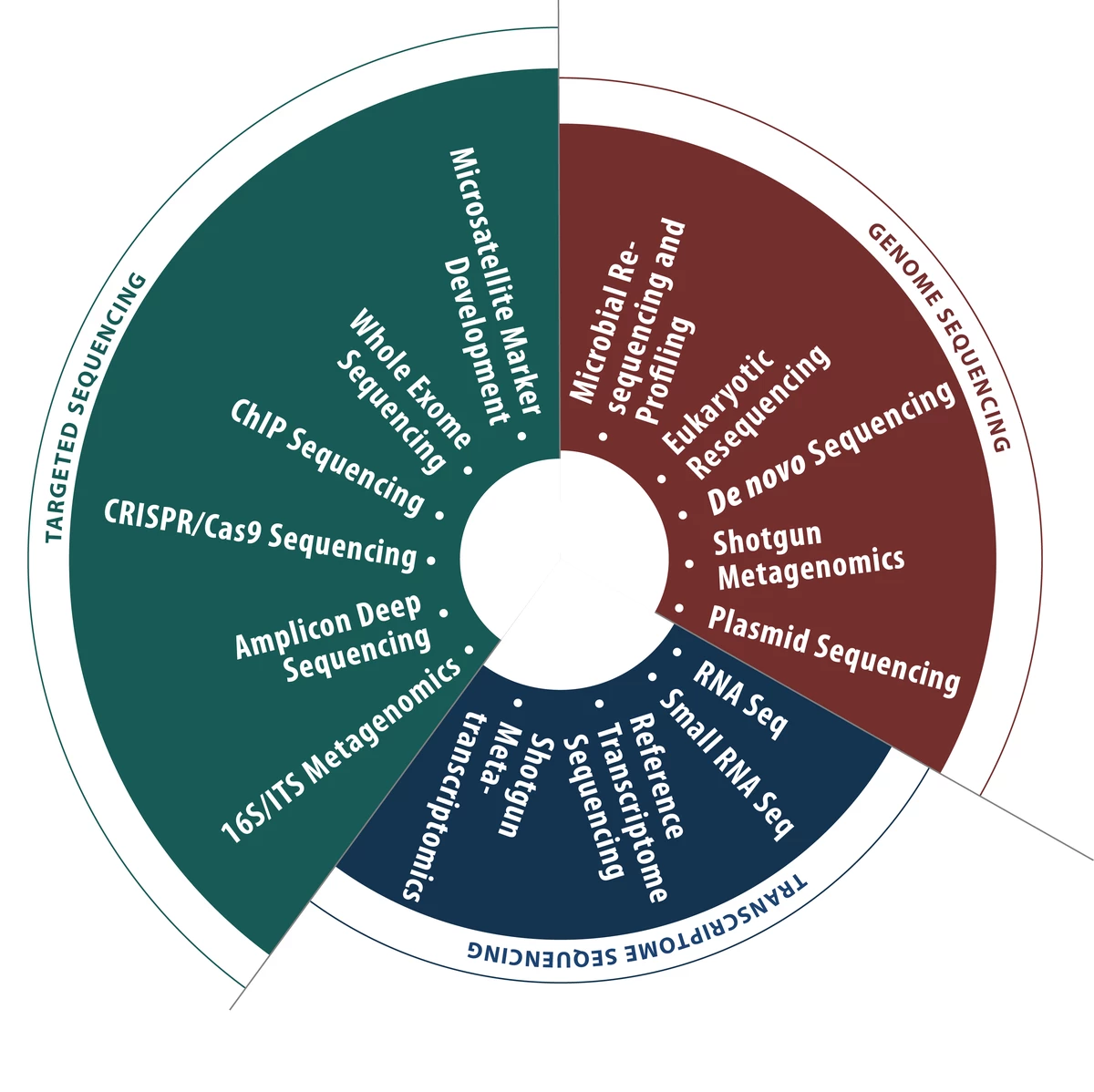Document
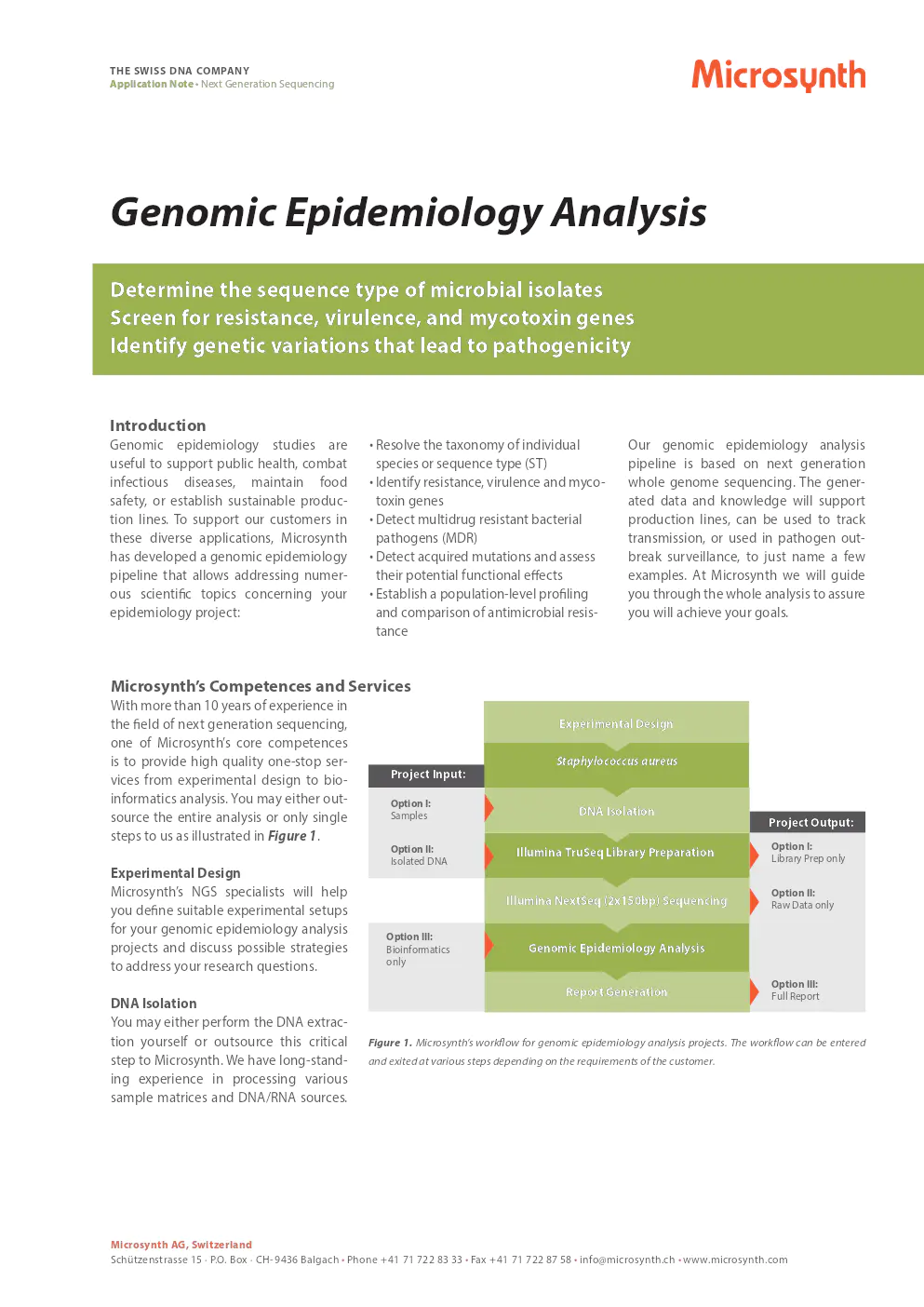
AN_GenomicEpidemiology

Contenu du document
Determine the sequence type of microbial isolates
Screen for resistance, virulence, and mycotoxin genes
Identify genetic variations that lead to pathogenicity
Introduction
Genomic epidemiology studies are
useful to support public health, combat
infectious diseases, maintain food
safety, or establish sustainable produc -
tion lines. To support our customers in
these diverse applications, Microsynth
has developed a genomic epidemiology
pipeline that allows addressing numer -
ous scientific topics concerning your
epidemiology project:
• Resolve the taxonomy of individual
species or sequence type (ST )
• Identify resistance, virulence and myco -
toxin genes
• Detect multidrug resistant bacterial
pathogens (MDR)
• Detect acquired mutations and assess
their potential functional effects
• Establish a population-level profiling
and comparison of antimicrobial resis -
tance
Our genomic epidemiology analysis
pipeline is based on next generation
whole genome sequencing. The gener -
ated data and knowledge will support
production lines, can be used to track
transmission, or used in pathogen out -
break surveillance, to just name a few
examples. At Microsynth we will guide
you through the whole analysis to assure
you will achieve your goals.
Genomic Epidemiology Analysis
Microsynth’s Competences and Services
With more than 10 years of experience in
the field of next generation sequencing,
one of Microsynth’s core competences
is to provide high quality one-stop ser -
vices from experimental design to bio -
informatics analysis. You may either out -
source the entire analysis or only single
steps to us as illustrated in Figure 1 .
Experimental Design
Microsynth’s NGS specialists will help
you define suitable experimental setups
for your genomic epidemiology analysis
projects and discuss possible strategies
to address your research questions.
DNA Isolation
You may either perform the DNA extrac -
tion yourself or outsource this critical
step to Microsynth. We have long-stand -
ing experience in processing various
sample matrices and DNA/RNA sources.
Figure 1. Microsynth’s workflow for genomic epidemiology analysis projects. The workflow can be entered
and exited at various steps depending on the requirements of the customer.
Genomic Epidemiology AnalysisProject Output:
Staphylococcus aureus
DNA Isolation
Illumina TruSeq Library Preparation
Illumina NextSeq (2x150bp) Sequencing
Option I:
Samples
Option II:
Isolated DNA
Project Input:
Report Generation
Option III:
Bioinformatics
only
Experimental Design
Option I:
Library Prep only
Option II:
Raw Data only
Option III:
Full Report
Microsynth AG, SwitzerlandSch?tzenstrasse 15 ? P.O. Box ? CH - 9436 Balgach ? Phone + 41fi71fi722fi83 33 ? Fax + 41fi71fi722fi87 58 ? info @microsynth.ch ? www.microsynth.com
THE SWISS DNA COMPANY Application Note ? Next Generation Sequencing
Example Results
Bioinformatics Analysis
Thanks to the use of modern methods
and algorithms, hundreds of samples can
be analyzed in detail for any genomic
epidemiology project. Depending on
the focus of the project, many different
approaches to bioinformatic analysis are
possible, but two example scenarios are
described in the next section.
In the first example scenario, the
genomes contained in the samples come
from well-studied model organisms.
However, since the composition of the
samples is unknown, a shotgun meta -
genome analysis is performed first to
determine whether the samples contain
pure strains or whether meta-communi -
ties exist, and in both cases the taxonomy
is determined (see Table 1 ). Assuming
that the samples contain pure strains of
a well-studied micro-organism, one of
the established Multi Locus Sequence
Typing (MLST ) schemes can be used to
determine its sequence type, which goes
beyond the determination of the species
alone (see Table 2 ).
Next, in order to reconstruct the strains
contained in the samples, the filtered
sequencing reads are de novo assem -
bled into contigs on which genes are
predicted and annotated. The predicted
genes are then screened for homologous
sequences among the known resistance,
virulence, and mycotoxin genes. Single
nucleotide variations (SNVs) and small
insertions and deletions (InDels) are
determined in comparison to the public
reference sequences (see Table 3 ).
In the second scenario, the microor -
ganisms to be analyzed are neither well
studied nor publicly documented. In
this case, determining the similarity of
the unknown genomes to any of the
genomes stored in the RefSeq [1] data -
base first and second annotate pre -
dicted genes with homologues found
for instance in the Pfam [2] database
(see Table 4 ) are sensible first steps. If no
exact phylogenetic relationship is known
for the hundreds of samples involved in
a genomic epidemiology project, clus -
tering can be used to establish groups
of samples that may then be further ana -
lyzed on their own [3] (see Figure 2 ).
Table 1. This cutout of a result of a shotgun metagenomics taxonomy assignment, shows the composition of the bacterial community found in the analyzed sample.
In this case, the sample contains 96 % of the Staphylococcus genus (Tax Level: G) and 92% are identified as Staphylococcus aureus species (Tax Level: S).
Table 2. The result of an MLST showing the sequence type of the species found in the sample. In this case, the scheme used for typing included seven genes (arcC, aroE,
glpF, gmk, pta, tpi and yqiL) to identify the respective ST and Clonal Complex (CC). The numbers in the gene columns represent different variants of these genes found
in the PubMLST database [4].
Table 3. Summary table of the number of observed SNVs and small InDels in the analyzed sample including the type of mutation (silent and non-silent).
Percent Tax Level Tax ID Tax Name
100.00 D 2 Bacteria
100.00 P 1239 Firmicutes
100.00 C 91061 Bacilli
96.00 O 1385 Bacillales
96.00 F 90964 Staphylococcaceae
96.00 G 1279 Staphylococcus
92.00 S 1280 Staphylococcus aureus
Sample arcC aroE glpF gmk pta tpi yqiL ST Clonal Complex
sample1 1 4 1 8 4 4 3 72 CC8
Sample SNV InDels Silent Non-silent
sample1 236 12 171 53
Library Preparation and Sequencing
Following a quality check of your
samples, Microsynth will build Illumina
libraries including specific adaptors with
barcodes. Depending on the experimen -
tal design, the libraries are pooled and
sequenced either on the Illumina MiSeq
or NextSeq 500/550. These flexible plat -
forms allow for optimal sequencing
depending on the number of samples
and on the required read length.
Microsynth AG, SwitzerlandSch?tzenstrasse 15 ? P.O. Box ? CH - 9436 Balgach ? Phone + 41fi71fi722fi83 33 ? Fax + 41fi71fi722fi87 58 ? info @microsynth.ch ? www.microsynth.com
THE SWISS DNA COMPANY Application Note ? Next Generation Sequencing
Related Services
Microsynth also provides microbial resequencing services that focus on the detection of genetic variations in relation to a refer -
ence sequence.
References
[1] O’Leary NA, Wright MW, Brister JR, Ciufo S, Haddad D, McVeigh R, Rajput B, Robbertse B, Smith-White B, Ako-Adjei D, Astashyn A,
Badretdin A, Bao Y, Blinkova O, Brover V, Chetvernin V, Choi J, Cox E, Ermolaeva O, Farrell CM, Goldfarb T, Gupta T, Haft D, Hatcher E,
Hlavina W, Joardar VS, Kodali VK, Li W, Maglott D, Masterson P, McGarvey KM, Murphy MR, O’Neill K, Pujar S, Rangwala SH, Rausch D,
Riddick LD, Schoch C, Shkeda A, Storz SS, Sun H, Thibaud-Nissen F, Tolstoy I, Tully RE, Vatsan AR, Wallin C, Webb D, Wu W, Landrum
MJ, Kimchi A, Tatusova T, DiCuccio M, Kitts P, Murphy TD, Pruitt KD. Reference sequence (RefSeq) database at NCBI: current status,
taxonomic expansion, and functional annotation. Nucleic Acids Res . 2016 Jan 4;44(D1):D733-45 PubMed
[2] S. El-Gebali, J. Mistry, A. Bateman, S.R. Eddy, A. Luciani, S.C. Potter, M. Qureshi, L.J. Richardson, G.A. Salazar, A. Smart, E.L.L.
Sonnhammer, L. Hirsh, L. Paladin, D. Piovesan, S.C.E. Tosatto, R.D. Finn. The Pfam protein families database in 2019. Nucleic Acids
Research (2019) doi: 10.1093/nar/gky995
[3] Lees JA, Harris SR, Tonkin-Hill G, Gladstone RA, Lo SW, Weiser JN, Corander J, Bentley SD, Croucher NJ. Fast and flexible bacterial
genomic epidemiology with PopPUNK. Genome Research 29:1-13 (2019). doi: 10.1101/gr.241455.118
[4] Website ( https://pubmlst.org/mlst/ ) sited at the University of Oxford (Jolley et al. Wellcome Open Res 2018, 3:124 [version 1; ref -
erees: 2 approved]). The development of this site has been funded by the Wellcome Trust.
Figure 2. Clustering of a large numbers of samples with unknown phylogenetic relationship resulting in four distinct groups.
Table 4. Detail of a table showing the homologous protein domains and their significance found for the predicted genes of the analyzed sample.
Target Name Accession Query Name E-value Score Description of Target
TPK_catalytic PF04263.16 gene_8|401_aa|-|7047|8252 0.00038 20.5 Thiamin pyrophosphokinase, catalytic domain
CRISPR_Cas9_WED PF18061.1 gene_40|840_aa|-|40414|42936 0.12 12.4 CRISPR-Cas9 WED domain
Microsynth AG, SwitzerlandSch?tzenstrasse 15 ? P.O. Box ? CH - 9436 Balgach ? Phone + 41fi71fi722fi83 33 ? Fax + 41fi71fi722fi87 58 ? info @microsynth.ch ? www.microsynth.com
THE SWISS DNA COMPANY Application Note ? Next Generation Sequencing
Entreprises concernées :
Produits concernés :
Date d'upload du document :
mardi 24 mai 2022
